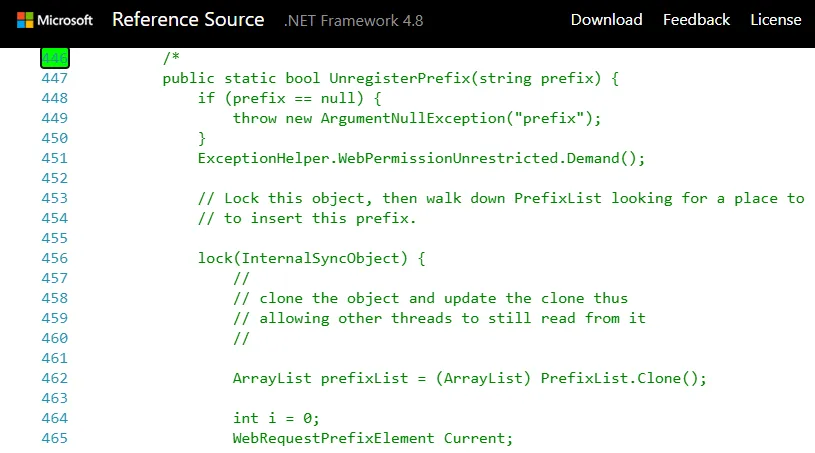Tricked by WebRequest
The Datadog .NET tracer uses the HTTP protocol to communicate with the agent (usually installed on the same machine) and send traces every second. We originally used HttpClient to handle the communication. However, we ran into some dependencies errors on .NET Framework (it’s a bit complicated and outside of the scope of the article, but it has something to do with us instrumenting the System.Net.HttpClient assembly while at the same time having a dependency on it), and so we decided to switch to HttpWebRequest. By doing so, we ran into a gotcha that some of you may already be aware of, but really blew my mind.
The setup
For various reasons, such as testability, we use an abstraction layer to send the HTTP request. We manipulate a IApiRequestFactory that returns instances of IApiRequest, which encapsulate the HTTP call. The code of our default IApiRequestFactory, using HttpWebRequest, was as straightforward as it gets:
internal class ApiWebRequestFactory : IApiRequestFactory
{
public IApiRequest Create(Uri endpoint)
{
return new ApiWebRequest((HttpWebRequest)WebRequest.Create(endpoint));
}
}
What could possibly go wrong?
Well, thank you for asking. We shipped this code confidently, and eventually got a bug report for a customer. The tracer was logging the following exception:
System.InvalidCastException: Unable to cast object of type 'Services.CompositionHttpWebRequest' to type 'System.Net.HttpWebRequest'.
at Datadog.Trace.Agent.ApiWebRequestFactory.Create(Uri endpoint)
at Datadog.Trace.Agent.Api.<SendTracesAsync>d__9.MoveNext()
Where does that Services.CompositionHttpWebRequest comes from? It turns out it’s possible to globally override the type of WebRequest used for any URL prefix! In this case, the customer was, for instrumentation purposes, doing something like:
WebRequest.RegisterPrefix("http://", new CustomWebRequestFactory());
Which caused subsequent calls to WebRequest.Create to return the custom type of WebRequest when used with HTTP. And therefore our code would crash when innocently trying to cast it to HttpWebRequest.
How to fix that? Well that’s when it struck me. I’ve always wondered about WebRequest.CreateHttp. I thought it was just a helper to avoid casting manually the WebRequest to HttpWebRequest, but it still seemed a bit odd to me. It turns out that it’s also a way to guarantee that you’ll get an HttpWebRequest even if somebody overrides the default factory.
Knowing that, the fix was a one-liner:
internal class ApiWebRequestFactory : IApiRequestFactory
{
public IApiRequest Create(Uri endpoint)
{
return new ApiWebRequest(WebRequest.CreateHttp(endpoint));
}
}
What about testing?
Writing a unit test was bit more challenging. I wanted my test to register a custom WebRequest factory, then call the ApiWebRequestFactory to make sure no exception was thrown. Unfortunately, I couldn’t find any supported way to unregister the factory. That’s a problem, because it would mean that the unit test could impact the next tests after executing. Interestingly, the source code for the UnregisterPrefix does exist but is commented out!
In the end, I decided to use reflection to manually unregister my custom factory at the end of the test. I did so by accessing the WebRequest.PrefixList static property to save the list of factories beforehand, then use the same property to restore the old value at the end of the test:
/// <summary>
/// This test ensures that the ApiWebRequestFactory behaves correctly when
/// a different type of WebRequest is assigned to the http:// prefix
/// </summary>
[Fact]
public void OverrideHttpPrefix()
{
// Couldn't find a way to "officially" unregister a prefix but that shouldn't stop us
var prefixListProperty = typeof(WebRequest).GetProperty("PrefixList", BindingFlags.Static | BindingFlags.NonPublic);
var oldPrefixList = prefixListProperty.GetValue(null);
WebRequest.RegisterPrefix("http://", new CustomWebRequestCreator());
// Make sure we properly hooked the WebRequest factory
Assert.IsType<FakeWebRequest>(WebRequest.Create("http://localhost/"));
try
{
var factory = new ApiWebRequestFactory();
var request = factory.Create(new Uri("http://localhost"));
Assert.NotNull(request);
}
finally
{
// Unregister the prefix
prefixListProperty.SetValue(null, oldPrefixList);
}
// Make sure we properly restored the old WebRequest factory
Assert.IsType<HttpWebRequest>(WebRequest.Create("http://localhost/"));
}
private class CustomWebRequestCreator : IWebRequestCreate
{
public WebRequest Create(Uri uri)
{
return new FakeWebRequest();
}
}
private class FakeWebRequest : WebRequest
{
}
It’s funny how after all this years I can still get tricked by one of the most commonly used types of the .NET Framework.

